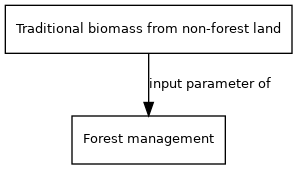Traditional biomass from non-forest land: Difference between revisions
Jump to navigation
Jump to search

ElkeStehfest (talk | contribs) No edit summary |
m (Text replace - "FAO, 2001" to "FAO, 2001a") |
||
| Line 5: | Line 5: | ||
|VariableType=external parameter | |VariableType=external parameter | ||
|Source2=FAO; | |Source2=FAO; | ||
|Reference2=assumptions based on FAO, | |Reference2=assumptions based on FAO, 2001a; FAO, 2008 | ||
|DriverGroup= | |DriverGroup= | ||
|Source= | |Source= | ||
| Line 11: | Line 11: | ||
|Reference= | |Reference= | ||
|Source3= | |Source3= | ||
|Reference2=assumptions based on FAO, | |Reference2=assumptions based on FAO, 2001a; FAO, 2008 | ||
}} | }} | ||
fracties moeten dus net andersom dan in de lange beschrijving, als het echt gaat om fraction from non-forested land. | fracties moeten dus net andersom dan in de lange beschrijving, als het echt gaat om fraction from non-forested land. | ||
Revision as of 11:00, 2 May 2014
| Label: | Fraction from non-forested land |
| Short description: | Fraction of traditional fuelwood from non-forestry sources like orchard, assumed to be 50% (low-income countries) and 68% (middle-income countries) |
| Description: | Part of the global energy demand is met by fuel wood, depending on the world region. For the developed regions, it is assumed in IMAGE that fuel wood is produced on a large scale and, therefore all fuel wood demand is added to timber demand. In the transitional regions as well as in the developing regions, smaller fractions of the fuel wood demand are assumed to be met from forestry operations: 50% and 32%. |
| Variable type: | external parameter |
| Source: | FAO; |
| Reference: | assumptions based on FAO, 2001a; FAO, 2008 |
External parameter is input of model component(s):

- Click on a box to open the model component.
fracties moeten dus net andersom dan in de lange beschrijving, als het echt gaat om fraction from non-forested land.